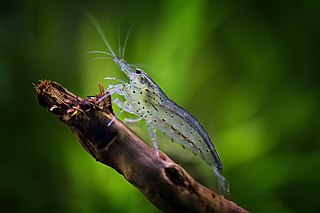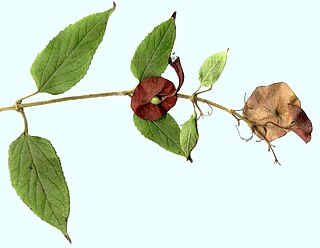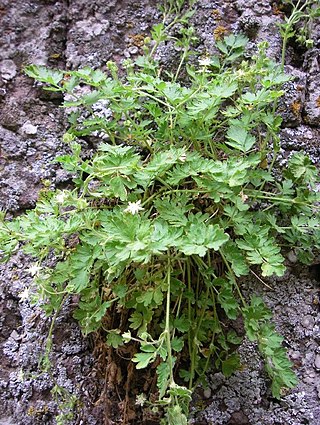
The modern pentathlon is an Olympic multisport that currently consists of fencing, freestyle swimming, equestrian show jumping, laser pistol shooting, and cross country running. Equestrian will be replaced by a form of obstacle course racing after the 2024 Summer Olympics.

An inflorescence, in a flowering plant, is a group or cluster of flowers arranged on a stem that is composed of a main branch or a system of branches. An inflorescence is categorized on the basis of the arrangement of flowers on a main axis (peduncle) and by the timing of its flowering.

Caridina multidentata is a species of shrimp in the family Atyidae. It is native to Japan and Taiwan. Its common names include Yamato shrimp, Japanese shrimp, Amano shrimp, and algae shrimp.

Takashi Amano was a professional track cyclist, photographer, designer, and aquarist. His interest in aquaria led him to create the Japanese company Aqua Design Amano.

Cryptocarya is a genus of about 360 species of flowering plants in the laurel family, Lauraceae. Most species are trees, occasionally shrubs, distributed through the Neotropical, Afrotropical, Indomalayan, and Australasian realms. Most plants in the genus Cryptocarya have leaves arranged alternately along the stems, small flowers with 6 tepals, stamens in 2 rows, the inner row alternating with staminodes, and the fruit is a drupe.

Cyme or Cumae was an Aeolian city in Aeolis close to the kingdom of Lydia. It was called Phriconian, perhaps from the mountain Phricion in Aeolis, near which the Aeolians had been settled before their migration to Asia.

Holmskioldia is a genus of flowering plants in the mint family, Lamiaceae. It is native to the Himalayas but widely cultivated as an ornamental and naturalized in many places It contains only one known species, Holmskioldia sanguinea, commonly called the Chinese hat plant, cup-and-saucer-plant or mandarin's hat.
Cyme is a genus of moths in the family Erebidae. The genus was described by Felder in 1861.
Livoniana is a genus of prehistoric tetrapodomorphs which lived during the Devonian period.

Potentilla baileyi, commonly known as Bailey's ivesia, is a species of flowering plant in the rose family.

Suriana is a monotypic genus of flowering plants containing only Suriana maritima, which is commonly known as bay cedar.

Cyme phryctopa is a moth of the family Erebidae. It is found in New Guinea.
Cyme effasciata is a species of moths in the family Erebidae. It is found on Ambon Island in Indonesia. It was described by Felder in 1861.
Sigournea is a genus of stem tetrapod from the Early Carboniferous. The genus contains only one species, the type species Sigournea multidentata, which was named in 2006 by paleontologists John R. Bolt and R. Eric Lombard on the basis of a single lower jaw from Iowa. The jaw came from a fissure-fill deposit of the St. Louis Limestone that was exposed in a quarry near the town of Sigourney and dates to the Viséan stage, making it approximately 335 million years old. Bolt and Lombard named the genus after Sigourney. The species name multidentata alludes to the many teeth preserved in the jaw. The jaw, which is housed in the Field Museum and cataloged as FM PR 1820, curves strongly downward but was probably straight to begin with, having been deformed by the process of fossilization after the individual died. Rooted in the dentary bone along the outermost edge of the jaw are 88 small, pointed marginal teeth. An additional row of even smaller teeth runs along the coronoids, three bones positioned lengthwise along the lower boundary of the dentary on the inner surface of the lower jaw. Bolt and Lombard were able to classify Sigournea as an early member of Tetrapoda based on the presence of bone surfaces covered in pits and ridges, a single row of dentary teeth, a jaw joint that faces upward, and an open groove for a lateral line along the outer surface of the jaw, and on the absence of teeth on the prearticular bone or enlarged fangs on the coronoids. Sigournea differs from other stem tetrapods in having several holes within a depression called the exomeckelian fenestra on the inner surface of the jaw.
Ultimate Fighting Championship (UFC) rankings, which were introduced in February 2013, are generated by a voting panel made up of media members. These media members are asked to vote for whom they feel are the top fighters in the UFC by weight class and pound-for-pound. A fighter is only eligible to be voted on if they are of active status in the UFC. A fighter can appear in more than one weight division at a time. The champion and interim champion are considered to be in top positions of their respective divisions and therefore are not eligible for voting by weight class. However, the champions can be voted on for the pound-for-pound rankings.

Chiricahua multidentata is a species of geometrid moth in the family Geometridae. It is found in Central America and North America.
Hemilienardia multidentata is a species of sea snail, a marine gastropod mollusk in the family Raphitomidae.

Cyme quadrilineata is a species of butterfly in the moth family Erebidae, found in Australian, near northeastern and northern coast.











